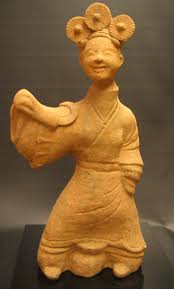Han Dynasty Painted Pottery 'Sichuan' Lady Dancer, 206 BCE - 220 CE
Terracotta
13.78 x 28.3
DL.1004
Further images
A type of work known as mingqi, literally translated as, “items for the next world,” this sculpture was specifically commissioned by the family of the deceased to be buried alongside...
A type of work known as mingqi, literally translated as, “items for the next world,” this sculpture was specifically commissioned by the family of the deceased to be buried alongside their departed relative, both as a symbol of their wealth and familial piety. However, only elite members of the social hierarchy could afford to be honored with such elaborate burials. During the Han era, the ancient Chinese believed that the afterlife was an extension of our earthly existences. Thus, the tombs of nobles and high-ranking officials were filled with sculpted renditions of their earthly entourage. Musicians, chefs, attendants, and guardians were placed alongside pots, vessels, cooking utensils, and herds of livestock. All these mingqi were expected to perform their functions continually throughout the afterlife. The guards would watch over the soul of the deceased, while the chef prepared meals, utilizing the meats of the livestock, and the musicians performed songs to nourish the spirit throughout eternity.
The smile that graces the face of this wonderful dancer is typical of the happy entertainers from the Sichuan Province. She wears an elaborate robe and a fantastic headdress featuring three flowers. The elegant posture of her legs, placed either side of a stool or pot, reflects the movement and action of the dance. A reflection of the wealth and sophistication of ancient China, this sculpture intrigues us with its vast historical and cultural insights. Furthermore, this work is a gorgeous symbol of the philosophical and religious belief of the Han. The eternal warmth and joy embodied by this ancient dancer brings a smile to our own faces.
The smile that graces the face of this wonderful dancer is typical of the happy entertainers from the Sichuan Province. She wears an elaborate robe and a fantastic headdress featuring three flowers. The elegant posture of her legs, placed either side of a stool or pot, reflects the movement and action of the dance. A reflection of the wealth and sophistication of ancient China, this sculpture intrigues us with its vast historical and cultural insights. Furthermore, this work is a gorgeous symbol of the philosophical and religious belief of the Han. The eternal warmth and joy embodied by this ancient dancer brings a smile to our own faces.









